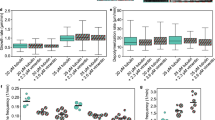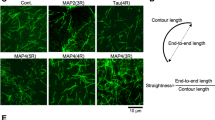Abstract
The cytoskeleton is a dynamic network that undergoes restructuring during various cellular events, influencing cell proliferation, differentiation, and apoptosis. Here, we report that accumulation of c-Jun, a member of the AP1 family of transcription factors that play a key role in normal and aberrant cell growth, dramatically increases upon depolymerization of the cytoskeleton, and that, unexpectedly, this increase is controlled translationally. Depolymerization of the actin or microtubule network induces an increase in c-Jun accumulation with no corresponding increase in c-Jun mRNA or in the half-life of the c-Jun protein, but rather in the translatability of its transcript. This increase is mediated by the untranslated regions (UTRs) of c-Jun mRNA, and is not dependent on activated mitogen-activated protein kinase pathways. This novel mechanism of c-Jun regulation might be relevant to physiological conditions in which c-Jun plays a pivotal role.
This is a preview of subscription content, access via your institution
Access options
Subscribe to this journal
Receive 50 print issues and online access
$259.00 per year
only $5.18 per issue
Buy this article
- Purchase on Springer Link
- Instant access to full article PDF
Prices may be subject to local taxes which are calculated during checkout







Similar content being viewed by others
References
Bakiri L, Lallemand D, Bossy-Wetzel E, Yaniv M . (2000). EMBO J 19: 2056–2068.
Blattner C, Kannouche P, Litfin M, Bender K, Rahmsdorf HJ, Angulo JF et al. (2000). Mol Cell Biol 20: 3616–3625.
Bonneau AM, Sonenberg N . (1987). J Biol Chem 262: 11134–11139.
Brenner DA, O'Hara M, Angel P, Chojkier M, Karin M . (1989). Nature 337: 661–663.
Chen CS, Mrksich M, Huang S, Whitesides GM, Ingber DE . (1997). Science 276: 1425–1428.
de Wet JR, Wood KV, DeLuca M, Helinski DR, Subramani S . (1987). Mol Cell Biol 7: 725–737.
Devary Y, Gottlieb RA, Lau LF, Karin M . (1991). Mol Cell Biol 11: 2804–2811.
Devary Y, Gottlieb RA, Smeal T, Karin M . (1992). Cell 71: 1081–1091.
Gupta S, Campbell D, Derijard B, Davis RJ . (1995). Science 267: 389–393.
Han J, Jiang Y, Li Z, Kravchenko VV, Ulevitch RJ . (1997). Nature 386: 296–299.
Han TH, Prywes R . (1995). Mol Cell Biol 15: 2907–2915.
Hattori K, Angel P, Le Beau MM, Karin M . (1988). Proc Natl Acad Sci USA 85: 9148–9152.
Herschman HR . (1991). Annu Rev Biochem 60: 281–319.
Kallunki T, Deng T, Hibi M, Karin M . (1996). Cell 87: 929–939.
Karin M . (1995). J Biol Chem 270: 16483–16486.
Kolbus A, Herr I, Schreiber M, Debatin KM, Wagner EF, Angel P . (2000). Mol Cell Biol 20: 575–582.
Kozak M . (1999). Gene 234: 187–208.
Lallemand D, Ham J, Garbay S, Bakiri L, Traincard F, Jeannequin O et al. (1998). EMBO J 17: 5615–5626.
Marinissen MJ, Chiariello M, Tanos T, Bernard O, Narumiya S, Gutkind JS . (2004). Mol Cell 14: 29–41.
Musti AM, Treier M, Bohmann D . (1997). Science 275: 400–402.
Nobes CD, Hall A . (1995). Cell 81: 53–62.
Oren A, Herschkovitz A, Ben-Dror I, Holdengreber V, Ben-Shaul Y, Seger R et al. (1999). Mol Cell Biol 19: 1742–1750.
Rajasekhar VK, Viale A, Socci ND, Wiedmann M, Hu X, Holland EC . (2003). Mol Cell 12: 889–901.
Reisfeld S, Vardimon L . (1994). Mol Endocrinol 8: 1224–1233.
Ryder K, Nathans D . (1988). Proc Natl Acad Sci USA 85: 8464–8467.
Schmid-Alliana A, Menou L, Manie S, Schmid-Antomarchi H, Millet MA, Giuriato S et al. (1998). J Biol Chem 273: 3394–3400.
Sehgal A, Briggs J, Rinehart-Kim J, Basso J, Bos TJ . (2000). Oncogene 19: 2836–2845.
Shaulian E, Karin M . (2002). Nat Cell Biol 4: E131–6.
Shaulian E, Schreiber M, Piu F, Beeche M, Wagner EF, Karin M . (2000). Cell 103: 897–907.
Short JD, Pfarr CM . (2002). J Biol Chem 277: 32697–32705.
Shtil AA, Mandlekar S, Yu R, Walter RJ, Hagen K, Tan TH et al. (1999). Oncogene 18: 377–384.
Sotiropoulos A, Gineitis D, Copeland J, Treisman R . (1999). Cell 98: 159–169.
Stone AA, Chambers TC . (2000). Exp Cell Res 254: 110–119.
Subbaramaiah K, Hart JC, Norton L, Dannenberg AJ . (2000). J Biol Chem 275: 14838–14845.
Swantek JL, Cobb MH, Geppert TD . (1997). Mol Cell Biol 17: 6274–6282.
Tapon N, Hall A . (1997). Curr Opin Cell Biol 9: 86–92.
Tarnowka MA, Baglioni C . (1979). J Cell Physiol 99: 359–367.
Treier M, Staszewski LM, Bohmann D . (1994). Cell 78: 787–798.
van Dam H, Wilhelm D, Herr I, Steffen A, Herrlich P, Angel P . (1995). EMBO J 14: 1798–1811.
Wang TH, Wang HS, Ichijo H, Giannakakou P, Foster JS, Fojo T et al. (1998). J Biol Chem 273: 4928–4936.
Xiao D, Pinto JT, Soh JW, Deguchi A, Gundersen GG, Palazzo AF et al. (2003). Cancer Res 63: 6825–6837.
Yujiri T, Fanger GR, Garrington TP, Schlesinger TK, Gibson S, Johnson GL . (1999). J Biol Chem 274: 12605–12610.
Yujiri T, Sather S, Fanger GR, Johnson GL . (1998). Science 282: 1911–1914.
Acknowledgements
We thank Drs M Cobb, M Karin, Y Kashman, J Kyriakis, R Prywes, R Seger, and E Shaulian for plasmids and reagents, Dr O Elroy-Stein for helpful suggestions and Dr M Yaniv for critical reading of the manuscript. This research was supported by the Israel Cancer Association and the Israel Science Foundation founded by the Israel Academy of Sciences and Humanities.
Author information
Authors and Affiliations
Corresponding author
Additional information
Supplementary Information accompanies the paper on Oncogene website (http://www.nature.com/onc)
Supplementary information
Rights and permissions
About this article
Cite this article
Polak, P., Oren, A., Ben-Dror, I. et al. The cytoskeletal network controls c-Jun translation in a UTR-dependent manner. Oncogene 25, 665–676 (2006). https://doi.org/10.1038/sj.onc.1209114
Received:
Revised:
Accepted:
Published:
Issue Date:
DOI: https://doi.org/10.1038/sj.onc.1209114



